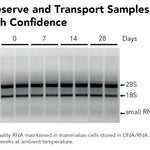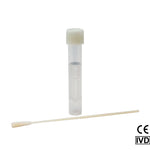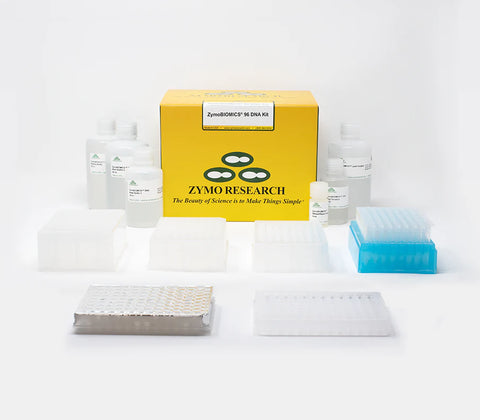Successfully Added to Cart
Customers also bought...
-
 DNA/RNA Shield (50 ml)Cat#: R1100-50DNA/RNA Shield reagent is a DNA and RNA stabilization solution for nucleic acids in any biological sample. This DNA and RNA stabilization solution preserves the...
DNA/RNA Shield (50 ml)Cat#: R1100-50DNA/RNA Shield reagent is a DNA and RNA stabilization solution for nucleic acids in any biological sample. This DNA and RNA stabilization solution preserves the... -
 DNA/RNA Shield SafeCollect Swab Collection Kit (1 ml fill) (1 collection kit)Cat#: R1160The DNA/RNA Shield SafeCollect Swab Collection Kit is a user-friendly collection kit for stabilizing the nucleic acid content of samples collected with a swab. DNA/RNA...
DNA/RNA Shield SafeCollect Swab Collection Kit (1 ml fill) (1 collection kit)Cat#: R1160The DNA/RNA Shield SafeCollect Swab Collection Kit is a user-friendly collection kit for stabilizing the nucleic acid content of samples collected with a swab. DNA/RNA...
Format
ZymoBIOMICS 96 DNA Kit
Highlights
- Validated Unbiased for Microbiome Measurements: Unbiased cellular lysis validated using the ZymoBIOMICS Microbial Community Standard.
- Inhibitor-Free DNA from Any Sample: Isolate ultra-pure DNA ready for any downstream application.
- Certified Low Bioburden: Boost your detection limit for low abundance microbes.
Original Manufacturer
Satisfaction 100% guaranteed, read Our Promise
Innovated in California, Made in the USA
Format
ZymoBIOMICS 96 DNA Kit
Highlights
- Validated Unbiased for Microbiome Measurements: Unbiased cellular lysis validated using the ZymoBIOMICS Microbial Community Standard.
- Inhibitor-Free DNA from Any Sample: Isolate ultra-pure DNA ready for any downstream application.
- Certified Low Bioburden: Boost your detection limit for low abundance microbes.
Original Manufacturer
Satisfaction 100% guaranteed, read Our Promise
Innovated in California, Made in the USA
| Cat # | Name | Size | |
|---|---|---|---|
| D4300-4-200 | ZymoBIOMICS DNA Wash Buffer 2 | 200 ml | |
| D4302-5-10 | ZymoBIOMICS DNase/RNase Free Water | 10 ml | |
| D4302-4-200 | ZymoBIOMICS MagWash 2 | 200 ml | |
| D4302-3-100 | ZymoBIOMICS MagWash 1 | 100 ml | |
| D4300-7-30 | ZymoBIOMICS HRC Prep Solution | 30 ml | |
| D4300-2-250 | ZymoBIOMICS DNA Binding Buffer | 250 ml | |
| D4300-3-100 | ZymoBIOMICS DNA Wash Buffer 1 | 100 ml | |
| D4300-1-150 | ZymoBIOMICS Lysis Solution | 150 ml | |
| S6012-50 | ZR BashingBead Lysis Tubes (0.1 & 0.5 mm) | 50 Tubes | |
| C2009 | Silicon-A-HRC Plate | 2 Plates | |
| S6002-96-3 | ZR-96 BashingBead Lysis Rack | 0.5 mm & 0.1 mm | |
| C2007-4 | 96-Well Plate Cover Foil | 4 Foils | |
| C2004 | |||
| P1001-2 | |||
Description
Performance
Technical Specifications
| Applicable For | All sensitive downstream applications such as qPCR and Next-Generation Sequencing. |
|---|---|
| Elution Volume | ≥ 20 µl DNA Elution Buffer or DNase free water |
| Equipment | Centrifuge with microplate carriers with height tolerance of 60 mm (2.36 inches) |
| Processing Volume | Fecal ≤100 mg, Soil ≤ 100 mg, Cells ≤ 20 mg (Approximately equal to 2x108 bacterial, 2x107 yeast, or 2x106 mammalian cells) |
| Purity | High quality, inhibitor-free DNA is eluted with ZymoBIOMICS DNase/RNase Free Water and is suitable for all downstream applications including PCR and Next-Generation sequencing |
| Sample Source | Bacterial, fungal, protozoan, algae, viral, mitochondrial, and host DNA is efficiently isolated from feces, soil, fungal/bacterial cells, biofilms and water. |
| Sample Storage | Eluted DNA should be stored at ≤ -20°C. |
| Size Range | Typically 15-20 kb post-bead beating. For optimal DNA integrity, collect samples in DNA/RNA Shield. |
| Type | Total DNA |
| Yield | Up to 5 µg total DNA can be eluted into 20 µl |
Resources
Documents
FAQ
Environmental samples often contain inhibitors such as polyphenolics, humic/fulvic acids, tannins, melanins, etc. that affect downstream applications such as PCR. The Zymo-Spin III-HRC is designed to remove these PCR inhibitors and does not bind DNA. The Zymo-Spin III-HRC can be purchased separately as the OneStep PCR Inhibitor Kit (D6030).
Check sample type and input amount. Low biomass samples such as swabs, some soil samples, water, air are expected to have low yield. High biomass samples such as feces may cause overloading of the spin column. Using less input may improve yields.
Ensure sample is fully homogenized. Depending on bead beater used, the settings may have to be optimized for each sample. The homogenization time may be extended to see if yields improve.
Apply heated elution buffer (60-70° C) and allow elution buffer to incubate on the column for several minutes prior to elution.
Ensure that the DNA Elution Buffer is added directly to the column matrix.
Low A260/230 values can be due to handling issues (e.g. transfer of column during wash steps). To minimize reagent wash buffer carryover, centrifuge the column at max speed for 1 minute prior to elution.
Spin down lysate and Binding Buffer mixture at max speed for 5 minutes, this will eliminate any debris not caught by Spin III-F filter. Also avoid debris in lysis tube when transferring lysate, spin at max speed after bashing for 1-3 minutes.
We have validated our kits with both high-speed homogenizers and low-speed disruptors. We highly recommend users to optimize their bead beating conditions for their own instruments. We recommend using a 2 ml-tube adapter to ensure that the bead beating is efficient (do not use adapters made of foam). You can reference the Optimized Lysis Protocols table under documents for some recommendations.
This is to remove any debris from the lysate that could interfere with the DNA binding to the silica membrane of the column.
Product Video
Citations
Workflow Generator
Build Your Custom Microbiome Workflow
A great tool to help build or complete your workflow with our comprehensive microbiome solutions!
Need help? Contact Us




